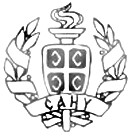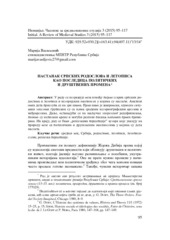| dc.creator | Васиљевић, Марија | |
| dc.date.accessioned | 2019-06-22T05:44:48Z | |
| dc.date.available | 2019-06-22T05:44:48Z | |
| dc.date.issued | 2015 | |
| dc.identifier.issn | 2334-8003 | |
| dc.identifier.uri | https://dais.sanu.ac.rs/123456789/6259 | |
| dc.identifier.uri | https://www.ceeol.com/search/article-detail?id=289299 | |
| dc.description.abstract | Апстракт: У раду се истражује веза између појаве старих српских родослова и летописа и историјских околности у којима су настали. Анализи ових дела приступа се на три нивоа. Први ниво је жанровски, односно сачувани текстови груписани су са њима сродним историографским врстама и међуврстама. Даље, ослањајући се на закључке теоретског редефинисања, поново су испитани време и могући разлози писања њихових првих примерака. На крају, рад се бави „решеткама перцепције“ аутора које указују на природу везе са политичким и друштвеним околностима у којима су дела настала. | sr |
| dc.description.abstract | Summary: This paper explores the relationship between the emergence of genealogies and chronicles and the specific social and political circumstances in which they originated. In that process, the ideology behind those texts is compared to the ideology of previous times, in search for the particular and specific history of medieval Serbian ideologies. Analysis of the hidden ideologies in these texts lead us to defining perceptual grids, which determine the nature of the writer’s perceptions and the manner in which he transmitted historical events. Understanding perceptual grids helps us to better determine the value of these sources for modern scholars. Research showed that former division of these sources, into genealogies, early chronicles and later chronicles, is not adequate. Therefore a new classification in accordance with the theory of genres and their evolution is proposed. The first group of sources may still be called genealogies, even though they are not just genealogies, but conflations between genres of hagiography and genealogy. The contents, typically hagiographic, are linked by the principle of hereditary succession into a chronological sequence. The older chronicles, are renamed to stemma-chronicles, another mixture of theoretically distinct genres. In stemma-chronicle content is also organized as a series of biographies in chronological sequence, connected by family affiliation. The difference between genealogies and stemma-chronicles is that in the former content is usually religiously oriented while in the later it is a balanced mix of historical accounts of secular and religious significance. It should be added, that in stemma-chronicles timelines are present, which is not the case with genealogies. The third group is named simple chronicles, instead of later chronicles, since it represent the genre in its pure form. Historical events are recorded by their date without connecting protagonists by affiliation. Apart from the theoretical redefinition of the sources, the paper offers a new time frame for their emergence. Bringing together historical circumstances, genre relations and their reciprocal influence and results of analysed contents it is argued that genealogies, stemma-chronicles and chronicles originated at or around the time of the battle of Marica River in 1371. Once again, the search for the past is shown to be guided by present necessities in turbulent and insecure times like those in the last quarter of the 14th century.
In the end, the last and maybe the most important conclusion of this paper is the definition of two types of perceptual grids found in examined sources. The first is the political and ideological perceptual grid, which is present in genealogies and stemma-chronicles. Representation and reinterpretation of history in those texts is conditioned by the intense contest for political power and authority, and these texts can be seen as a textual analogy of that struggle. The second one can be called the historical perceptual grid, because history was not used as a field of political competition for political power, but as a means of remembering events that are important for the community and thereby creating a collective identity. | en |
| dc.language.iso | sr | sr |
| dc.relation | info:eu-repo/grantAgreement/MESTD/Basic Research (BR or ON)/177029/RS// | sr |
| dc.rights | openAccess | sr |
| dc.rights.uri | https://creativecommons.org/licenses/by/4.0/ | |
| dc.source | Иницијал: часопис за средњовековне студије | sr |
| dc.subject | средњи век | sr |
| dc.subject | Србија | sr |
| dc.subject | родослови | sr |
| dc.subject | летописи | sr |
| dc.subject | летописи-стеме | sr |
| dc.subject | решетка перцепције | sr |
| dc.title | Настанак српских родослова и летописа као последица политичких и друштвених промена | sr |
| dc.type | article | sr |
| dc.rights.license | BY | sr |
| dcterms.abstract | Vasiljević, Marija; Nastanak srpskih rodoslova i letopisa kao posledica političkih i društvenih promena; | |
| dc.citation.spage | 95 | |
| dc.citation.epage | 117 | |
| dc.citation.volume | 3 | |
| dc.type.version | publishedVersion | sr |
| dc.identifier.fulltext | https://dais.sanu.ac.rs/bitstream/id/19609/bitstream_19609.pdf | |
| dc.identifier.rcub | https://hdl.handle.net/21.15107/rcub_dais_6259 | |

